A Comprehensive Report on Behavioural Disorders: ASD, ADHD, SEBD
VerifiedAdded on 2022/08/16
|5
|1236
|16
Report
AI Summary
This report provides an overview of three key behavioral disorders: Autism Spectrum Disorder (ASD), Attention Deficit Hyperactivity Disorder (ADHD), and Social, Emotional, and Behavioural Difficulties (SEBD). It defines each disorder, highlighting their characteristics and symptoms. The report discusses the challenges faced by individuals with these conditions, including difficulties in communication, social interaction, and learning. It explores potential causes, such as neurodevelopmental factors and environmental influences. The report also touches upon associated issues like sensory sensitivities, impulsivity, and emotional regulation problems. References to relevant research are included to support the information provided. This report serves as an informative resource for understanding these complex behavioral disorders.
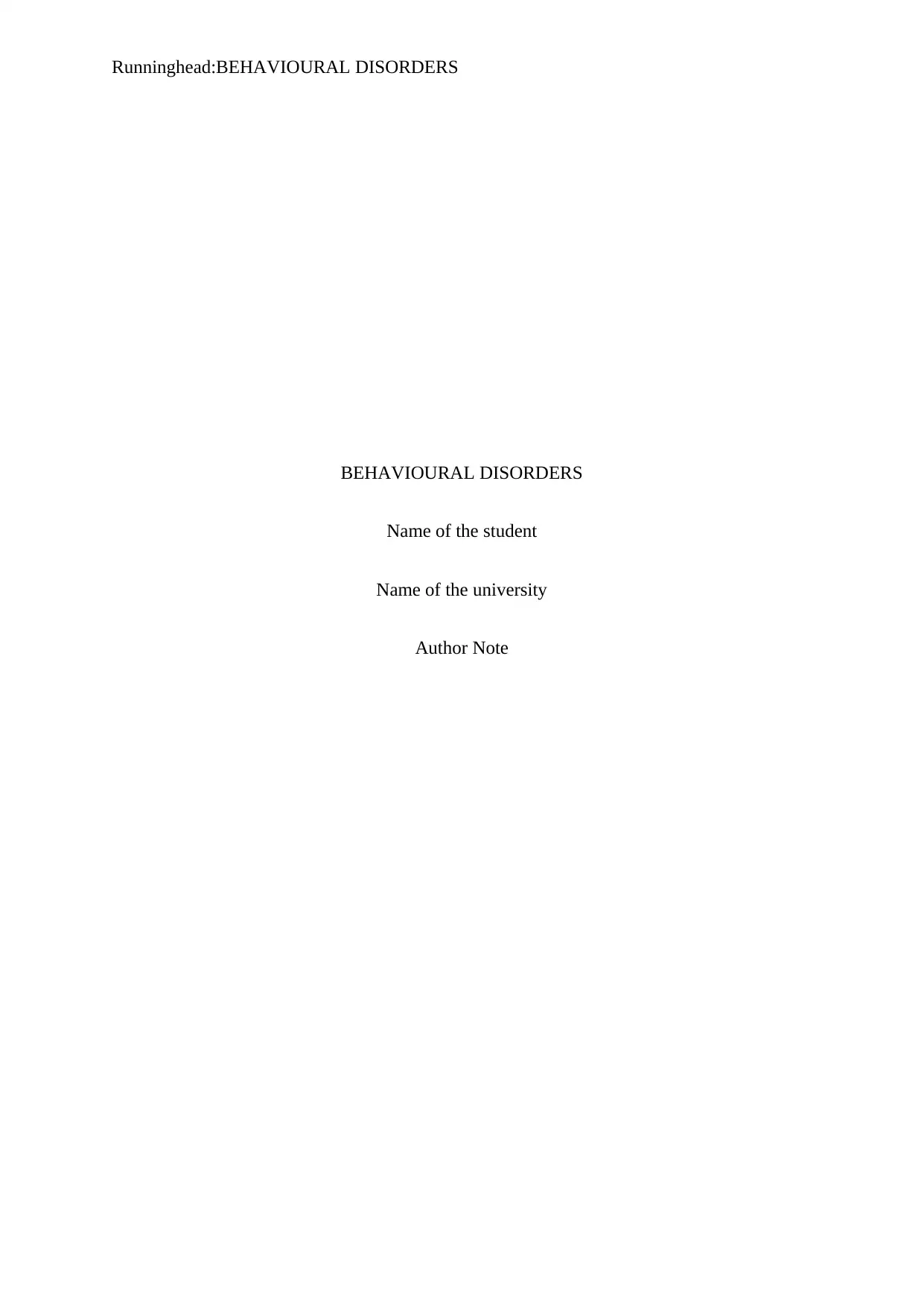
Runninghead:BEHAVIOURAL DISORDERS
BEHAVIOURAL DISORDERS
Name of the student
Name of the university
Author Note
BEHAVIOURAL DISORDERS
Name of the student
Name of the university
Author Note
Paraphrase This Document
Need a fresh take? Get an instant paraphrase of this document with our AI Paraphraser
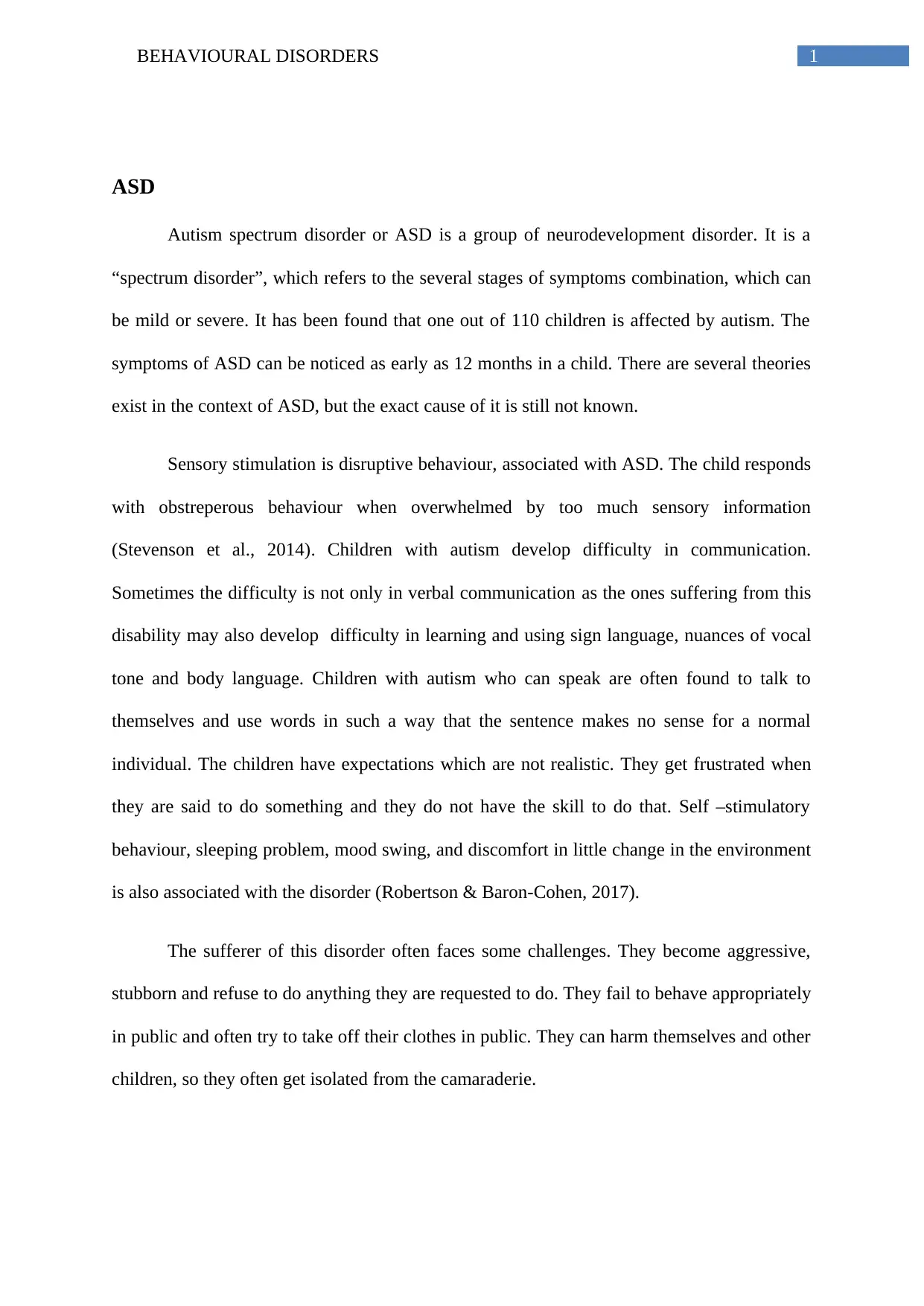
1BEHAVIOURAL DISORDERS
ASD
Autism spectrum disorder or ASD is a group of neurodevelopment disorder. It is a
“spectrum disorder”, which refers to the several stages of symptoms combination, which can
be mild or severe. It has been found that one out of 110 children is affected by autism. The
symptoms of ASD can be noticed as early as 12 months in a child. There are several theories
exist in the context of ASD, but the exact cause of it is still not known.
Sensory stimulation is disruptive behaviour, associated with ASD. The child responds
with obstreperous behaviour when overwhelmed by too much sensory information
(Stevenson et al., 2014). Children with autism develop difficulty in communication.
Sometimes the difficulty is not only in verbal communication as the ones suffering from this
disability may also develop difficulty in learning and using sign language, nuances of vocal
tone and body language. Children with autism who can speak are often found to talk to
themselves and use words in such a way that the sentence makes no sense for a normal
individual. The children have expectations which are not realistic. They get frustrated when
they are said to do something and they do not have the skill to do that. Self –stimulatory
behaviour, sleeping problem, mood swing, and discomfort in little change in the environment
is also associated with the disorder (Robertson & Baron-Cohen, 2017).
The sufferer of this disorder often faces some challenges. They become aggressive,
stubborn and refuse to do anything they are requested to do. They fail to behave appropriately
in public and often try to take off their clothes in public. They can harm themselves and other
children, so they often get isolated from the camaraderie.
ASD
Autism spectrum disorder or ASD is a group of neurodevelopment disorder. It is a
“spectrum disorder”, which refers to the several stages of symptoms combination, which can
be mild or severe. It has been found that one out of 110 children is affected by autism. The
symptoms of ASD can be noticed as early as 12 months in a child. There are several theories
exist in the context of ASD, but the exact cause of it is still not known.
Sensory stimulation is disruptive behaviour, associated with ASD. The child responds
with obstreperous behaviour when overwhelmed by too much sensory information
(Stevenson et al., 2014). Children with autism develop difficulty in communication.
Sometimes the difficulty is not only in verbal communication as the ones suffering from this
disability may also develop difficulty in learning and using sign language, nuances of vocal
tone and body language. Children with autism who can speak are often found to talk to
themselves and use words in such a way that the sentence makes no sense for a normal
individual. The children have expectations which are not realistic. They get frustrated when
they are said to do something and they do not have the skill to do that. Self –stimulatory
behaviour, sleeping problem, mood swing, and discomfort in little change in the environment
is also associated with the disorder (Robertson & Baron-Cohen, 2017).
The sufferer of this disorder often faces some challenges. They become aggressive,
stubborn and refuse to do anything they are requested to do. They fail to behave appropriately
in public and often try to take off their clothes in public. They can harm themselves and other
children, so they often get isolated from the camaraderie.
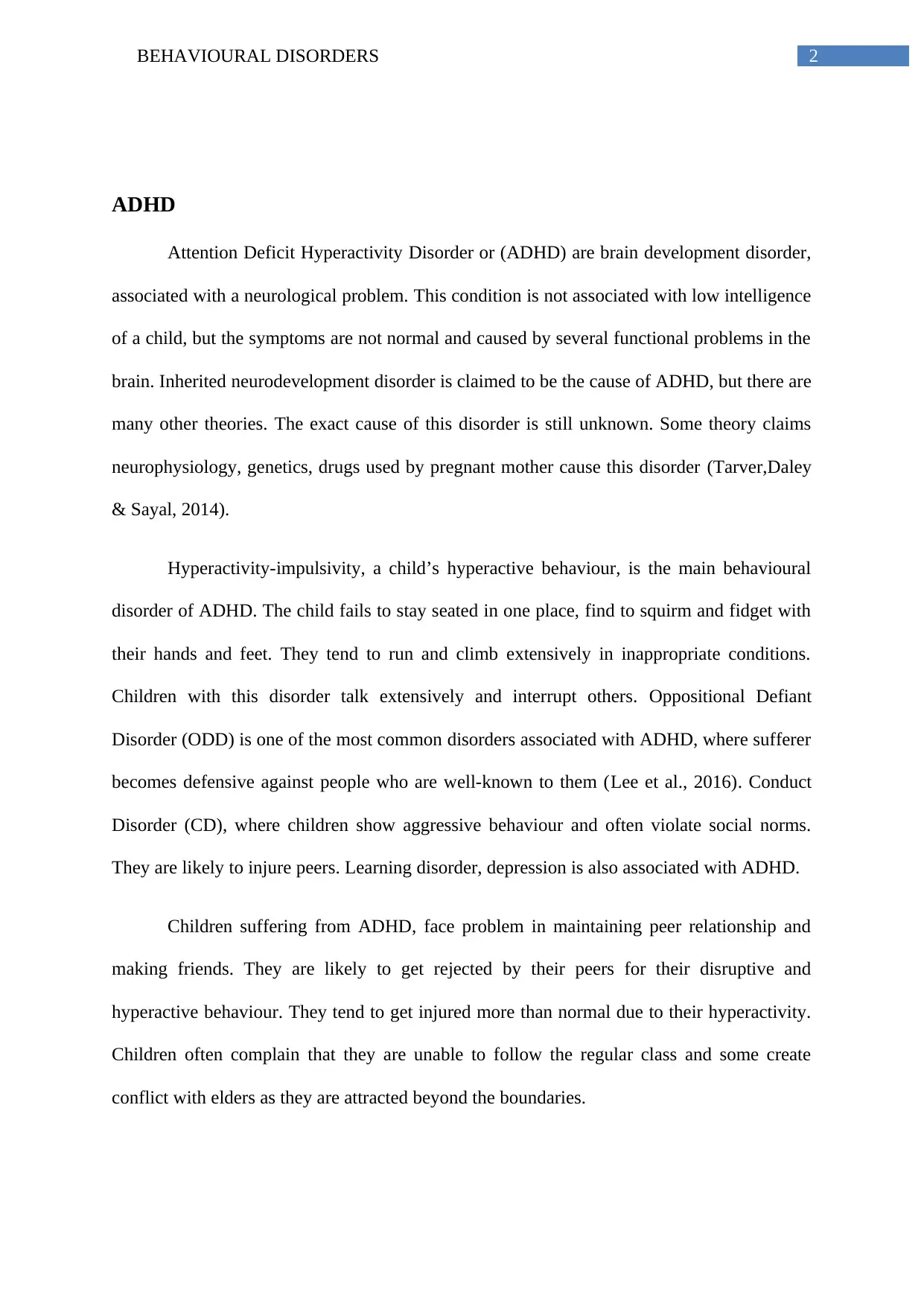
2BEHAVIOURAL DISORDERS
ADHD
Attention Deficit Hyperactivity Disorder or (ADHD) are brain development disorder,
associated with a neurological problem. This condition is not associated with low intelligence
of a child, but the symptoms are not normal and caused by several functional problems in the
brain. Inherited neurodevelopment disorder is claimed to be the cause of ADHD, but there are
many other theories. The exact cause of this disorder is still unknown. Some theory claims
neurophysiology, genetics, drugs used by pregnant mother cause this disorder (Tarver,Daley
& Sayal, 2014).
Hyperactivity-impulsivity, a child’s hyperactive behaviour, is the main behavioural
disorder of ADHD. The child fails to stay seated in one place, find to squirm and fidget with
their hands and feet. They tend to run and climb extensively in inappropriate conditions.
Children with this disorder talk extensively and interrupt others. Oppositional Defiant
Disorder (ODD) is one of the most common disorders associated with ADHD, where sufferer
becomes defensive against people who are well-known to them (Lee et al., 2016). Conduct
Disorder (CD), where children show aggressive behaviour and often violate social norms.
They are likely to injure peers. Learning disorder, depression is also associated with ADHD.
Children suffering from ADHD, face problem in maintaining peer relationship and
making friends. They are likely to get rejected by their peers for their disruptive and
hyperactive behaviour. They tend to get injured more than normal due to their hyperactivity.
Children often complain that they are unable to follow the regular class and some create
conflict with elders as they are attracted beyond the boundaries.
ADHD
Attention Deficit Hyperactivity Disorder or (ADHD) are brain development disorder,
associated with a neurological problem. This condition is not associated with low intelligence
of a child, but the symptoms are not normal and caused by several functional problems in the
brain. Inherited neurodevelopment disorder is claimed to be the cause of ADHD, but there are
many other theories. The exact cause of this disorder is still unknown. Some theory claims
neurophysiology, genetics, drugs used by pregnant mother cause this disorder (Tarver,Daley
& Sayal, 2014).
Hyperactivity-impulsivity, a child’s hyperactive behaviour, is the main behavioural
disorder of ADHD. The child fails to stay seated in one place, find to squirm and fidget with
their hands and feet. They tend to run and climb extensively in inappropriate conditions.
Children with this disorder talk extensively and interrupt others. Oppositional Defiant
Disorder (ODD) is one of the most common disorders associated with ADHD, where sufferer
becomes defensive against people who are well-known to them (Lee et al., 2016). Conduct
Disorder (CD), where children show aggressive behaviour and often violate social norms.
They are likely to injure peers. Learning disorder, depression is also associated with ADHD.
Children suffering from ADHD, face problem in maintaining peer relationship and
making friends. They are likely to get rejected by their peers for their disruptive and
hyperactive behaviour. They tend to get injured more than normal due to their hyperactivity.
Children often complain that they are unable to follow the regular class and some create
conflict with elders as they are attracted beyond the boundaries.
⊘ This is a preview!⊘
Do you want full access?
Subscribe today to unlock all pages.

Trusted by 1+ million students worldwide
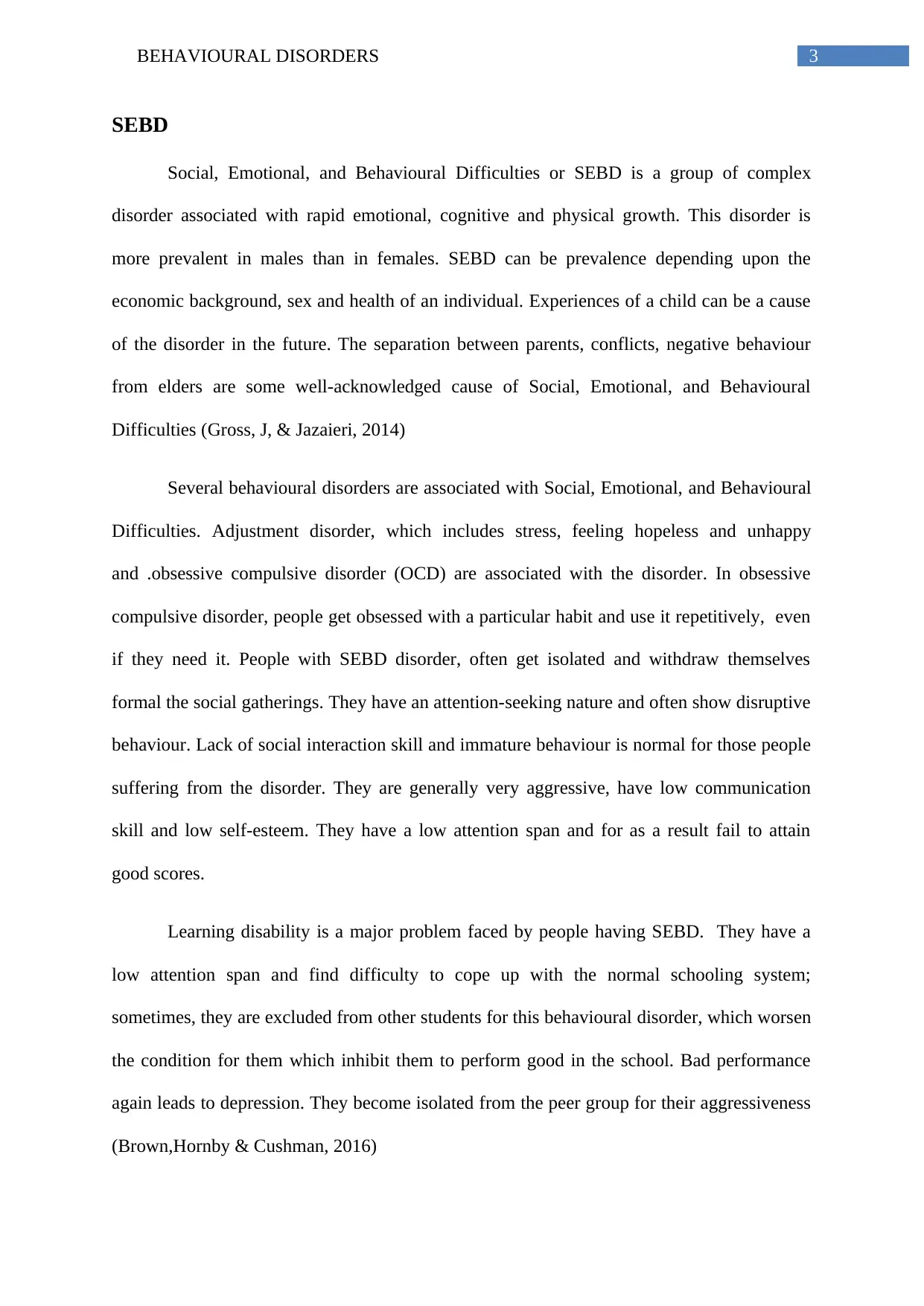
3BEHAVIOURAL DISORDERS
SEBD
Social, Emotional, and Behavioural Difficulties or SEBD is a group of complex
disorder associated with rapid emotional, cognitive and physical growth. This disorder is
more prevalent in males than in females. SEBD can be prevalence depending upon the
economic background, sex and health of an individual. Experiences of a child can be a cause
of the disorder in the future. The separation between parents, conflicts, negative behaviour
from elders are some well-acknowledged cause of Social, Emotional, and Behavioural
Difficulties (Gross, J, & Jazaieri, 2014)
Several behavioural disorders are associated with Social, Emotional, and Behavioural
Difficulties. Adjustment disorder, which includes stress, feeling hopeless and unhappy
and .obsessive compulsive disorder (OCD) are associated with the disorder. In obsessive
compulsive disorder, people get obsessed with a particular habit and use it repetitively, even
if they need it. People with SEBD disorder, often get isolated and withdraw themselves
formal the social gatherings. They have an attention-seeking nature and often show disruptive
behaviour. Lack of social interaction skill and immature behaviour is normal for those people
suffering from the disorder. They are generally very aggressive, have low communication
skill and low self-esteem. They have a low attention span and for as a result fail to attain
good scores.
Learning disability is a major problem faced by people having SEBD. They have a
low attention span and find difficulty to cope up with the normal schooling system;
sometimes, they are excluded from other students for this behavioural disorder, which worsen
the condition for them which inhibit them to perform good in the school. Bad performance
again leads to depression. They become isolated from the peer group for their aggressiveness
(Brown,Hornby & Cushman, 2016)
SEBD
Social, Emotional, and Behavioural Difficulties or SEBD is a group of complex
disorder associated with rapid emotional, cognitive and physical growth. This disorder is
more prevalent in males than in females. SEBD can be prevalence depending upon the
economic background, sex and health of an individual. Experiences of a child can be a cause
of the disorder in the future. The separation between parents, conflicts, negative behaviour
from elders are some well-acknowledged cause of Social, Emotional, and Behavioural
Difficulties (Gross, J, & Jazaieri, 2014)
Several behavioural disorders are associated with Social, Emotional, and Behavioural
Difficulties. Adjustment disorder, which includes stress, feeling hopeless and unhappy
and .obsessive compulsive disorder (OCD) are associated with the disorder. In obsessive
compulsive disorder, people get obsessed with a particular habit and use it repetitively, even
if they need it. People with SEBD disorder, often get isolated and withdraw themselves
formal the social gatherings. They have an attention-seeking nature and often show disruptive
behaviour. Lack of social interaction skill and immature behaviour is normal for those people
suffering from the disorder. They are generally very aggressive, have low communication
skill and low self-esteem. They have a low attention span and for as a result fail to attain
good scores.
Learning disability is a major problem faced by people having SEBD. They have a
low attention span and find difficulty to cope up with the normal schooling system;
sometimes, they are excluded from other students for this behavioural disorder, which worsen
the condition for them which inhibit them to perform good in the school. Bad performance
again leads to depression. They become isolated from the peer group for their aggressiveness
(Brown,Hornby & Cushman, 2016)
Paraphrase This Document
Need a fresh take? Get an instant paraphrase of this document with our AI Paraphraser
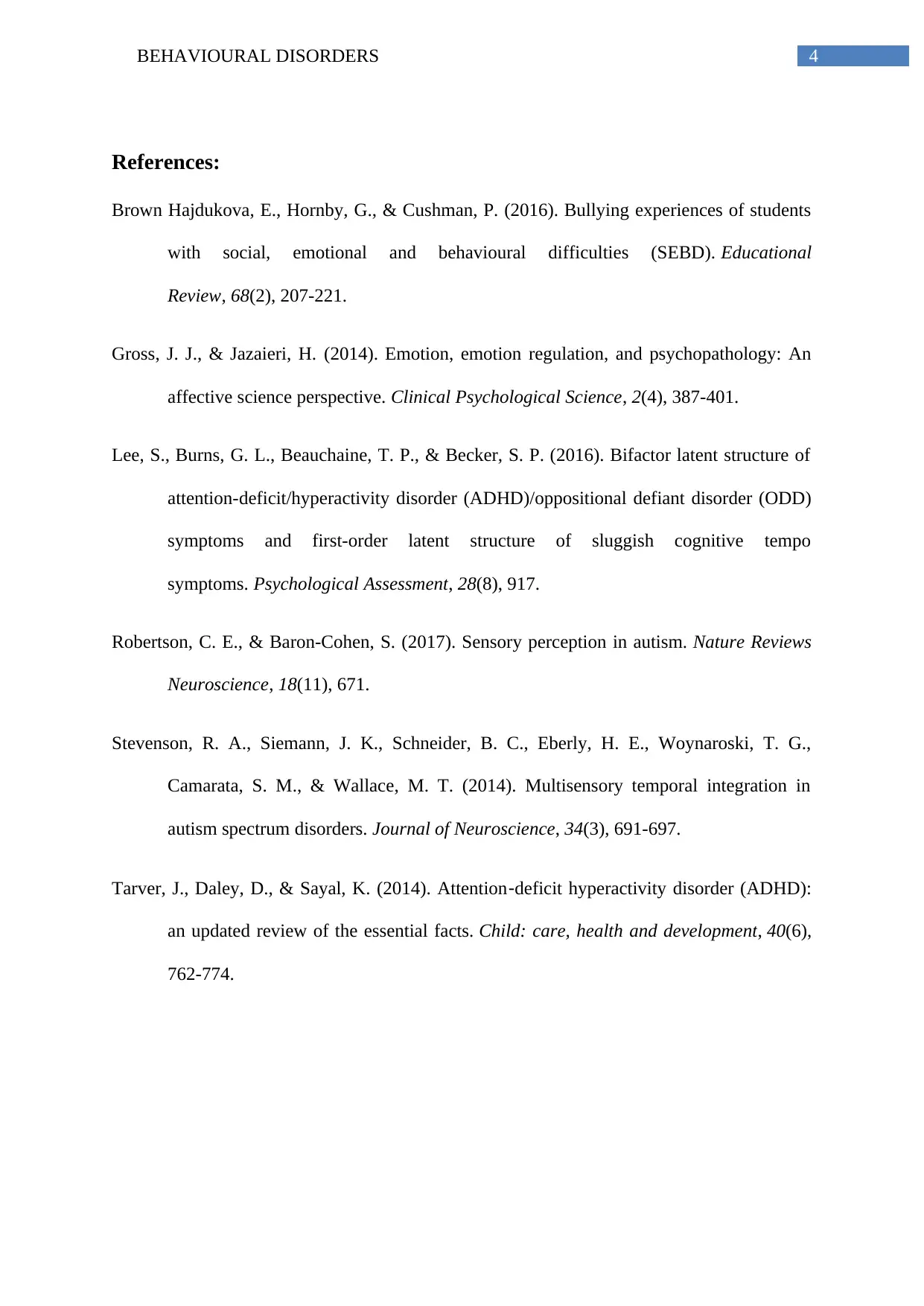
4BEHAVIOURAL DISORDERS
References:
Brown Hajdukova, E., Hornby, G., & Cushman, P. (2016). Bullying experiences of students
with social, emotional and behavioural difficulties (SEBD). Educational
Review, 68(2), 207-221.
Gross, J. J., & Jazaieri, H. (2014). Emotion, emotion regulation, and psychopathology: An
affective science perspective. Clinical Psychological Science, 2(4), 387-401.
Lee, S., Burns, G. L., Beauchaine, T. P., & Becker, S. P. (2016). Bifactor latent structure of
attention-deficit/hyperactivity disorder (ADHD)/oppositional defiant disorder (ODD)
symptoms and first-order latent structure of sluggish cognitive tempo
symptoms. Psychological Assessment, 28(8), 917.
Robertson, C. E., & Baron-Cohen, S. (2017). Sensory perception in autism. Nature Reviews
Neuroscience, 18(11), 671.
Stevenson, R. A., Siemann, J. K., Schneider, B. C., Eberly, H. E., Woynaroski, T. G.,
Camarata, S. M., & Wallace, M. T. (2014). Multisensory temporal integration in
autism spectrum disorders. Journal of Neuroscience, 34(3), 691-697.
Tarver, J., Daley, D., & Sayal, K. (2014). Attention‐deficit hyperactivity disorder (ADHD):
an updated review of the essential facts. Child: care, health and development, 40(6),
762-774.
References:
Brown Hajdukova, E., Hornby, G., & Cushman, P. (2016). Bullying experiences of students
with social, emotional and behavioural difficulties (SEBD). Educational
Review, 68(2), 207-221.
Gross, J. J., & Jazaieri, H. (2014). Emotion, emotion regulation, and psychopathology: An
affective science perspective. Clinical Psychological Science, 2(4), 387-401.
Lee, S., Burns, G. L., Beauchaine, T. P., & Becker, S. P. (2016). Bifactor latent structure of
attention-deficit/hyperactivity disorder (ADHD)/oppositional defiant disorder (ODD)
symptoms and first-order latent structure of sluggish cognitive tempo
symptoms. Psychological Assessment, 28(8), 917.
Robertson, C. E., & Baron-Cohen, S. (2017). Sensory perception in autism. Nature Reviews
Neuroscience, 18(11), 671.
Stevenson, R. A., Siemann, J. K., Schneider, B. C., Eberly, H. E., Woynaroski, T. G.,
Camarata, S. M., & Wallace, M. T. (2014). Multisensory temporal integration in
autism spectrum disorders. Journal of Neuroscience, 34(3), 691-697.
Tarver, J., Daley, D., & Sayal, K. (2014). Attention‐deficit hyperactivity disorder (ADHD):
an updated review of the essential facts. Child: care, health and development, 40(6),
762-774.
1 out of 5
Related Documents
Your All-in-One AI-Powered Toolkit for Academic Success.
+13062052269
info@desklib.com
Available 24*7 on WhatsApp / Email
![[object Object]](/_next/static/media/star-bottom.7253800d.svg)
Unlock your academic potential
Copyright © 2020–2025 A2Z Services. All Rights Reserved. Developed and managed by ZUCOL.





